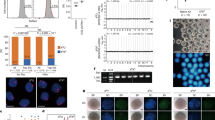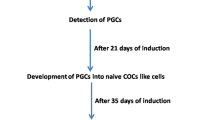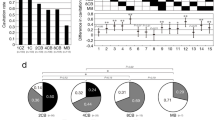Abstract
Until recently, fertilization was the only way to produce viable mammalian offspring, a process implicitly involving male and female gametes. However, techniques involving fusion of embryonic or fetal somatic cells with enucleated oocytes have become steadily more successful in generating cloned young1,2,3. Dolly the sheep4 was produced by electrofusion of sheep mammary-derived cells with enucleated sheep oocytes. Here we investigate the factors governing embryonic development by introducing nuclei from somatic cells (Sertoli, neuronal and cumulus cells) taken from adult mice into enucleated mouse oocytes. We found that some enucleated oocytes receiving Sertoli or neuronal nuclei developed in vitro and implanted following transfer, but none developed beyond 8.5 days post coitum; however, a high percentage of enucleated oocytes receiving cumulus nuclei developed in vitro. Once transferred, many of these embryos implanted and, although most were subsequently resorbed, a significant proportion (2 to 2.8%) developed to term. These experiments show that for mammals, nuclei from terminally differentiated, adult somatic cells of known phenotype introduced into enucleated oocytes are capable of supporting full development.
This is a preview of subscription content, access via your institution
Access options
Subscribe to this journal
Receive 51 print issues and online access
$199.00 per year
only $3.90 per issue
Buy this article
- Purchase on Springer Link
- Instant access to full article PDF
Prices may be subject to local taxes which are calculated during checkout





Similar content being viewed by others
References
Campbell, K. H. S., Loi, P., Otaegui, P. J. & Wilmut, I. Cell cycle co-ordination in embryo cloning by nuclear transfer. Rev. Reprod. 1, 40–45 (1996).
Kono, T. Nuclear transfer and reprogramming. Rev. Reprod. 2, 74–80 (1997).
Campbell, K. H. S., McWhir, J., Ritchie, W. A. & Wilmut, I. Sheep cloned by nuclear transfer from a cultured cell line. Nature 380, 64–66 (1996).
Wilmut, I., Schnieke, A. E., McWhir, J., Kind, A. J. & Campbell, K. H. S. Viable offspring derived from fetal and adult mammalian cells. Nature 385, 810–813 (1997).
Schuetz, A. W., Whittingham, D. G. & Snowden, R. Alterations in the cell cycle of mouse cumulus granulosa cells during expansion and mucification in vivo and in vitro. Reprod. Fertil. Dev. 8, 935–943 (1996).
Wassarman, P. The biology and chemistry of fertilization. Science 235, 553–560 (1987).
Epstein, C. J. The Consequences of Chromosome Imbalance (Cambridge University Press, 1986).
Yanagida, K., Yanagimachi, R., Perreault, S. D. & Kleinfeld, R. G. Thermostabiity of sperm nuclei assessed by microinjection into hamster oocytes. Biol. Reprod. 44, 440–447 (1991).
McGrath, J. & Solter, D. Inability of mouse blastmere nuclei transferred to enucleated zygotes to support development in vitro. Science 226, 1317–1319 (1984).
Willadsen, S. M. Nuclear transplantation in sheep embryos. Nature 320, 63–65 (1986).
Collas, P. & Barnes, F. L. Nuclear transplantation by microinjection of inner cell mass and granulosa cell nuclei. Mol. Reprod. Dev. 38, 264–267 (1994).
Czolowska, R., Modlinski, J. A. & Tarkowski, A. K. Behavior of thymocyte nuclei in non-activated and activated mouse oocytes. J. Cell Sci. 69, 19–34 (1984).
Tsunoda, T. & Kato, Y. Nuclear transplantation of embryonic stem cells in mice. J. Reprod. Fertil. 98, 537–540 (1993).
Tsunoda, T., Tokunaga, T., Imai, I. & Uchida, T. Nuclear transplantation of male primordial germ cells in the mouse. Development 107, 407–411 (1989).
Kono, T., Ogawa, M. & Nakahara, T. Thymocyte transfer to enucleated oocytes in the mouse. J. Reprod. Dev. 39, 301–307 (1993).
Kimura, Y. & Yanagimachi, R. Intracytoplasmic sperm injection in the mouse. Biol. Reprod. 52, 709–720 (1995).
Kimura, Y. & Yanagimachi, R. Mouse oocytes injected with testicular spermatozoa or round spermatids can develop into normal offspring. Development 121, 2397–2405 (1995).
Eppig, J., Wigglesworth, K., Pendola, F. & Hirao, Y. Murine oocytes suppress expression of luteinizing hormone receptor messenger ribonucleic acid by granulosa cells. Biol. Reprod. 56, 976–984 (1997).
Chatot, C. L., Lewis, J. L., Torres, I. & Ziomek, C. A. Development of 1-cell embryos from different strains of mice in CZB medium. Biol. Reprod. 42, 432–440 (1990).
Erickson, R. P., Zwigman, T. & Ao, A. Gene expression, X-inactivation, and methylation during spermatogenesis: the case of Zfa, Zfx and Zfy in mice. Mol. Reprod. Dev. 35, 114–120 (1993).
1. Kuretake, S., Kimura, Y., Hoshi, K. & Yanagimachi, R. Fertilization and development of mouse oocytes injected with isolated sperm heads. Biol. Reprod. 55, 789–795 (1996).
Kono, T., Sotomaru, Y., Sato, Y. & Nakahara, T. Development of androgenetic mouse embryos produced by in vitro fertilization of enucleated oocytes. Mol. Reprod. Dev. 34, 43–46 (1993).
Bos-Mikich, A., Whittingham, D. G. & Kones, K. T. Meiotic and Mitotic Ca2+ oscillations affect cell composition in resulting blastocysts. Dev. Biol. 182, 172–179 (1997).
Dietrich, W. et al. Agenetic map of the mouse suitable for typing intraspecific crosses. Genetics 131, 423–447 (1992).
Taylor, B. A. & Rowe, L. Amouse linkage testing stock possessing multiple copies of the endogenous ecotropic murine leukemia virus genome. Genomics 5, 221–232 (1989).
Johnson, K. R., Cook, S. A. & Davisson, M. T. Chromosomal localization of the murine gene and two related sequences encoding high-mobility-group I and Y proteins. Genomics 12, 503–509 (1992).
Acknowledgements
This study was supported in part by grants from the National Institutes of Health, ProBio America Inc., and fellowships from the Japanese Society for the Promotion of Science (T.W.) and European Molecular Biology Organization (A.C.F.P.). We thank H. Tateno for chromosome analysis, Y.Nakamura for help with DNA fingerprinting, H. Kishikawa, T. Kasai and R. Kleinfeld for assistance in preparing this manuscript, and J. Eppig for help and advice.
Author information
Authors and Affiliations
Rights and permissions
About this article
Cite this article
Wakayama, T., Perry, A., Zuccotti, M. et al. Full-term development of mice from enucleated oocytes injected with cumulus cell nuclei. Nature 394, 369–374 (1998). https://doi.org/10.1038/28615
Received:
Accepted:
Published:
Issue Date:
DOI: https://doi.org/10.1038/28615
This article is cited by
-
Reprogramming mechanism dissection and trophoblast replacement application in monkey somatic cell nuclear transfer
Nature Communications (2024)
-
Serum starvation is as efficient as roscovitine on the cycle synchronization in G0/G1 of red-rumped agouti fibroblasts
In Vitro Cellular & Developmental Biology - Animal (2024)
-
Unreprogrammed H3K9me3 prevents minor zygotic genome activation and lineage commitment in SCNT embryos
Nature Communications (2023)
-
Sir Ian Wilmut 1944–2023
Nature Biotechnology (2023)
Comments
By submitting a comment you agree to abide by our Terms and Community Guidelines. If you find something abusive or that does not comply with our terms or guidelines please flag it as inappropriate.



